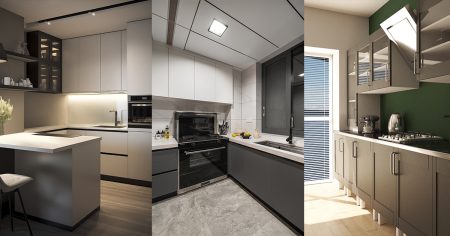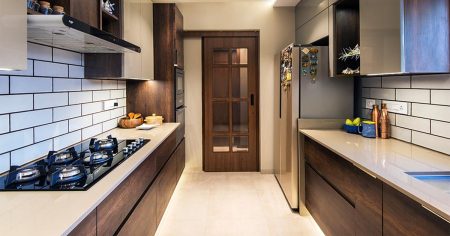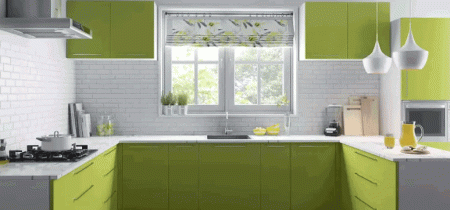The term kitchen island refers to a cabinet/countertop unit that is accessible from all sides and is not bounded by any walls. It can be a portable or fixed piece and can range from a simple small work surface to a large unit that is virtually a self-contained kitchen all on its own.
Kitchen islands are among the most in-demand features for new or remodeled kitchens, as they can make the space considerably more functional and enjoyable. But choosing the right island can be complicated since your options can range from simple, portable units to very complex permanent structures that incorporate built-in appliances, and plumbing or wiring service.
Your most important choice will be between a portable/mobile type of island, and some form of fixed, permanent island that is served by utilities. No matter what kind of island you get, make sure the placement is functional.
In increasing order of complexity and investment, you’ll find five options to consider when choosing which kitchen island is best for you and your space.
-
01
of 06Rolling Cart Island
Rolling carts are more like portable prep areas that you keep to the side of the kitchen rather than featuring prominently and permanently. The butcher block cart is a familiar type of rolling island. These can be good options for small kitchens, where they can be brought out only when needed.
Rolling carts can also be locked in a central location on a semi-permanent basis in a small galley, U- or L-shape kitchen layout, but moved when more open space is required. There are even small portable dishwashers with butcher block tops that provide a moveable work surface around the kitchen.
Best For
Mobile kitchen island/carts work well in any small kitchen or for homeowners who move frequently. Even if your kitchen has a larger, full-service island, adding a mobile cart gives you more flexibility and options for storage.
Pros-
Affordable
-
Can be moved around where needed
-
Can be tucked out of the way when not in use
Cons-
Wheels may become unlocked, causing rolling
-
Can be heavy to move
-
Work space usually rather small
-
-
02
of 06Small, Non-Portable Kitchen Island
These islands differ from the portable, rolling cart islands listed above in that they do not have wheels on the bottom. More importantly, they actually strive to emulate a traditional kitchen island. Normally 38 inches tall, they are the right height for prepping food. They don’t have the tendency of those rolling carts to slide away when you’re trying to cut something.
To avoid triggering the electrical code’s requirement for the installation of receptacles, do not affix this type of island to the floor. In this way, they technically are considered portable units. You may also be surprised at the smallness of these islands: Since they are sold flat-packed and are often freighted or mailed to you, they need to be rather compact, and four feet long tends to be the maximum length.
Best For
This kitchen island is ideal for small but heavily used kitchens. It works well in apartments, condos, or in galley- or corridor-style kitchens.
Pros-
Simple, functional design
-
Looks like a traditional island rather than than a cart
-
Good choice for small kitchens
Cons-
Flip-up side leaves are sometimes unstable
-
Difficult to move around
-
Work/storage space often rather small
-
-
03
of 06Counter-Height Work Table
A work table is essentially a countertop without the built-in storage features. It is normally elevated to the same height as perimeter countertops, though it’s also possible to use a small ordinary dining table, which has a lower height, for this purpose. Larger countertop work tables can be permanently anchored to the floor, but smaller ones can be left unattached to be moveable. Remember that larger, fixed work surfaces will need to have electrical service installed.
This type of island can be good for smaller kitchens, since it has a lighter visual footprint. It can also be a good choice if you prefer to sit at a stool with your knees beneath the counter while doing food preparation.
Best For
This type of kitchen island is best for adding affordable working space with a light visual imprint. Work tables can be tucked away when not needed. Plus, they give you a chance to try out the kitchen island experience before making the costlier decision to install a permanent kitchen island.
Pros-
Can double as an eating counter.
-
Light visual footprint
-
Relatively inexpensive
Cons-
No storage
-
Styles may not match cabinets
-
May move if not affixed to floor
-
-
04
of 06Base Cabinet With Countertop
This type of island is built out of pre-existing materials: a base cabinet (or two or four, positioned back-to-back), topped with countertop material. These configurations are normally fixed in place, often anchored to the floor with cleats. Such islands are sometimes matched with upper cabinets suspended from the ceiling.
But because this type of island is a fixed-in-place unit, building codes consider it to be a built-in that will require electrical service if the countertop is larger than 12 x 24 inches.
Best For
This type of kitchen island can be installed in a wide variety of kitchens, and it’s a good starting point even if you think you may eventually want more services.
Pros-
Easiest from of built-in kitchen island
-
Flexible
-
DIY construction is possible
Cons-
Countertop material must be cut to size
-
Requires some carpentry work
-
Usually requires electrical service
Continue to 5 of 6 below. -
-
05
of 06Fully Functional Island (Electricity and Plumbing)
The fully functional kitchen island has everything that the primary countertops do: electrical, sink, drainage, and ample countertop space. Plus, with a countertop overhang, it can provide space for seated prep work, in-kitchen dining, or entertaining.
The installation costs for this kind of island can skyrocket due to the addition of plumbing. The sink’s supply and drainage do not conveniently tap into the main plumbing lines hidden inside walls. Thus, your island’s lines will have to run into and under the floor to connect to the main water supply and drain lines.
Providing proper drain venting adds a further complication to this installation. This is often done through a special high-loop inside the cabinet that then routes down below the floor to link up with a traditional wall vent stack running up through the roof. Another option, if allowed by code, is a special air-admittance valve (AAV) that fits inside the cabinet to allow fresh air into the system to prevent siphoning which can occur as water drains.
Best For
Large, open-concept kitchens are best suited for this type of full-function kitchen island. Adding all of these services to the island isn’t cheap, so you’ll need to have a good reason for adding them. Unless you’re a cook who needs an auxiliary cooking and prep area, it’s often best to stick with a more basic type of island.
Pros-
Practically doubles kitchen work space
-
Adds value to home
-
Ideal for large remodeled “open concept” kitchens
Cons-
Expensive to install
-
Makes future remodeling difficult
-
Usually requires professional electrical, plumbing work.
-
-
06
of 06Double-Tiered Cooking/Eating Kitchen Island
Is it a kitchen island for cooking or is it a kitchen island for eating? It can’t quite make up its mind, so it has decided to be both. This island combines the two functions but still delineates them so that cooking is done on a lower level and eating on a higher level. This type of island can be as all-encompassing and as expensive to install as the fully-functional island described above.
This type of island is ergonomically correct: the optimal counter height for a standing cook is 36 inches, and the best height for a bar top is 42 inches. But the ledge from the cooking surface to the eating surface cuts back on total preparation space.
Best For
A double-tier kitchen island is best for large family kitchens, entertainment kitchens, or for residents who do a lot of in-kitchen dining.
Pros-
Ergonomically correct
-
Highly functional; good choice for “open concept” kitchens
-
Adds real estate value
Cons-
Inconvenient division of space
-
Can cut off kitchen from adjacent area
-
An expensive option; may require electrical, and sometimes plumbing work
-
Choosing a Kitchen Island
Kitchen islands come in a wide range of styles, from simple portable units that offer a small additional work surface and minimal storage, to enormous fixed units that hold kitchen appliances, sinks, and sometimes even eating spaces.
The right choice depends on your available space, your budget, and whether or not you will need electrical and plumbing service on your island. Although the investment in a full-featured island may seem prohibitive, its impact on home value may make it the best choice in the long run.
Space considerations include more than just square footage. For example, although you may technically have the space for a large kitchen island, it may not make sense for the way the appliances are placed.
For example, if the refrigerator is across the room from the oven, you don’t want to have to walk around a large obstacle every time you need an ingredient. In such cases, a smaller island—or even a portable unit—might make the most sense.
Read the full article here














